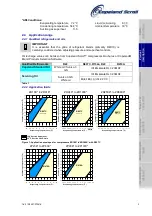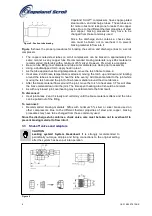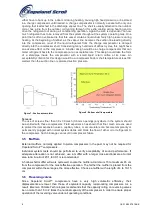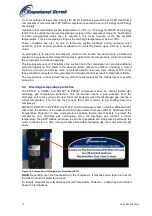
16
C6.2.19/0507-0708/E
5.4
Charging procedure
Do not operate compressor without enough system charge to maintain at least 0.5 bar
suction pressure.
Do not operate with a restricted suction.
Do not operate with the low-pressure cut-out bridged.
Allowing pressure to drop below 0.5 bar for more than a few seconds may overheat
scrolls and cause early drive bearing damage.
Do not use compressor to test opening set point of high-pressure cut-out.
Bearings are susceptible to damage before they have had several hours of normal
running in.
The system should be liquid-charged through the liquid-receiver shut-off valve or through a valve
in the liquid line. The use of a filter drier in the charging line is highly recommended. Because
R410A and R407C are blends and scrolls have discharge check valves, systems should be
liquid-charged on both the high and low side simultaneously to ensure a positive refrigerant
pressure is present in the compressor before it runs. The majority of the charge should be
placed in the high side of the system to prevent bearing washout during first-time start on the
assembly line.
5.5
Rotation direction
Scroll compressors, like several other types of compressors, will only compress in one rotational
direction. Direction of rotation is not an issue with single-phase compressors since they will
always start and run in the proper direction. Three-phase compressors will rotate in either
direction depending upon phasing of the power. Since there is a 50-50 chance of connecting
power in such a way as to cause rotation in the reverse direction
, it is important to include
notices and instructions in appropriate locations on the equipment to ensure proper
rotation direction when the system is installed and operated
.
Observing that suction pressure drops and discharge pressure rises when the compressor is
energized allows verification of proper rotation direction. There is no negative impact on
durability caused by operating three-phase Copeland Scroll
compressors in the reversed
direction for a short period of time (under one hour) but oil may be lost. Oil loss can be prevented
during reverse rotation if the tubing is routed at least 15 cm above the compressor. After several
minutes of operation in reverse, the compressor's protection system will trip due to high motor
temperature. The operator will notice a lack of cooling. However, if allowed to repeatedly restart
and run in reverse without correcting the situation, the compressor will be permanently
damaged.
All three-phase scroll compressors are identically wired internally. Therefore, once the correct
phasing is determined for a specific system or installation, connecting properly phased power
leads to the identified compressor terminals will ensure proper rotation direction.
5.6
Starting
During the very brief start-up, a clicking sound is audible, resulting from initial contacting of the
spirals and is normal. Due to the design of the Copeland Scroll
compressors, the internal
compression components always start unloaded even if system pressures are not balanced. In
addition, since internal compressor pressures are always balanced at start-up, low-voltage
starting characteristics are excellent for Copeland Scroll
compressors.
5.7
Deep vacuum operation
Copeland Scroll
compressors should never be used to evacuate a refrigeration or air-
conditioning system.
The scroll compressor can be used to pump down refrigerant in a unit as
long as the pressures remain within the operating envelope. Low suction pressures will result in
overheating of the scrolls and permanent damage to the compressor drive bearing. ZP and ZR
scrolls incorporate internal low vacuum protection, the floating seal unloads when the pressure
ratio exceeds approximately 10:1.
Содержание Copeland Scroll ZP23K Series
Страница 24: ... ...




















